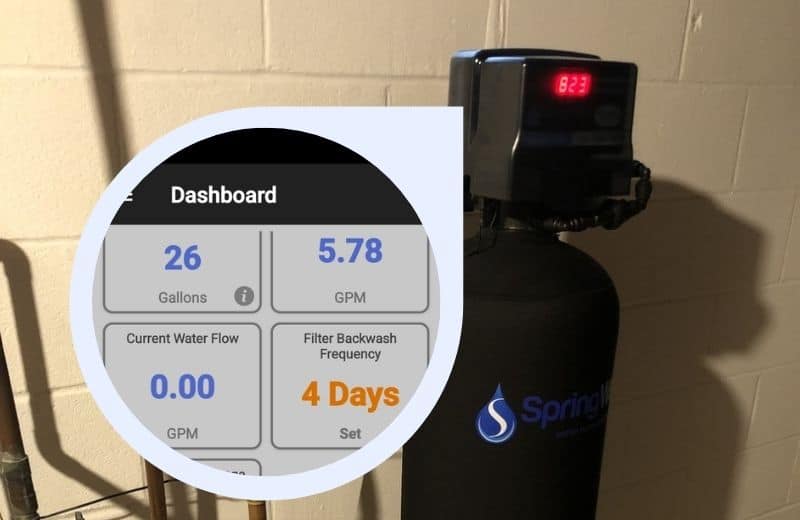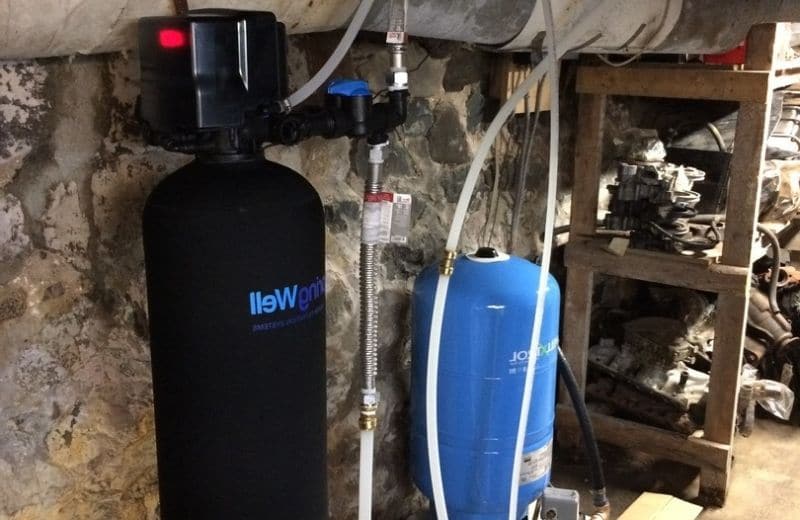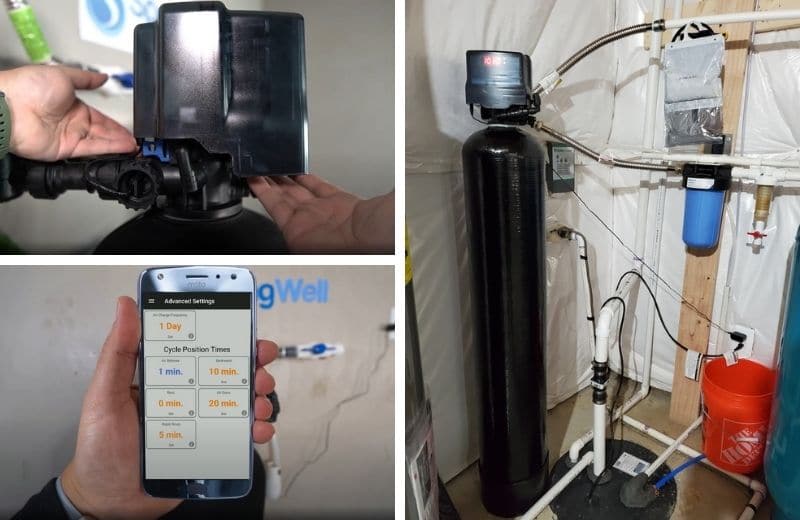We wanted to find the best solution for filtering iron, hydrogen sulfide, and manganese out of our well water, and the SpringWell WS caught our attention as being one of the most popular well water filter systems available today.
We’ve used the SpringWell WS to treat our groundwater supply in the Rocky Mountains near Telluride, Colorado.
We evaluated the system across a variety of performance categories, including its ability to remove our well water contaminants, the media longevity, its backflushing efficiency, and more. Find out how it performed in our testing in this guide.
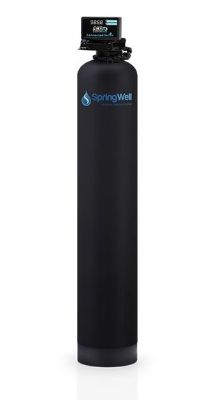
SpringWell WS Whole House Well Water Filter System
The SpringWell WS system is one of the most capable well water filtration systems on the market. We love this well water filtration system because it’s an all-rounder, removing high quantities of iron, manganese, and sulfur, rather than putting the main focus on only one of these contaminants. Plus, it has an excellent flow rate.
Table of Contents
🧾 Overview
The Springwell Whole House Well Water Filter, also known as the SpringWell WS, is a high-capacity well water filtration system designed to remove up to 7 PPM of iron, 8 PPM of hydrogen sulfide, and 1 PPM of manganese.
It’s a point-of-entry system, which means it treats your water upstream of your water heater, so your entire home’s hot and cold water supplies are filtered.
There are a few different methods of removing the iron and other well water minerals, and the SpringWell WS uses air injection/oxidation (or AIO). The idea is that water flows through an oxygen-rich air pocket at the top of the tank, which oxidizes the contaminants. These oxidized contaminants are then trapped in a greensand filtration media. When the system backwashes, the accumulated contaminants are flushed away down a drain, refreshing the media.
We could choose between two water filtration systems in the WS series:
- The 12 GPM WS1, for homes with 1-4 bathrooms
- The 20 GPM WS4, for homes with 4+ bathrooms
There’s no difference in the quality of water filtration between these two systems – both use the same air injection/oxidation filtration process, and they’re both made from the same durable, certified components.
The key difference is system size and capacity, which is linked to flow rate. Most folks won’t need anything bigger than the WS1, but if you have a large home or a small commercial setup, you may need to upgrade to the higher-flow WS4 model.
The WS is protected by SpringWell’s leading limited lifetime warranty. It was reassuring to know that our investment was protected, and we could make a warranty claim if we encountered a design or manufacturing fault.
The WS also comes with a 6-month money-back satisfaction guarantee, which meant we could return it within this 6-month trial period if we decided we didn’t love it. But there’s a drawback to this – we’d be responsible for the return shipping costs, and there’s a 25% restocking fee, so we wouldn’t get a full refund.
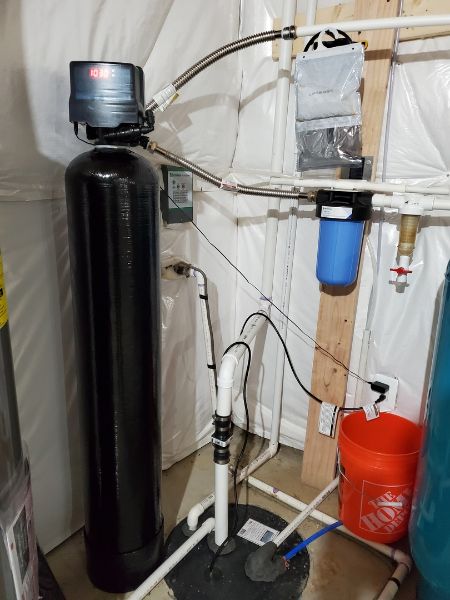
| Tank width | 10” (1-4 bathrooms), 13” (4+ bathrooms) |
| Tank height | 54” or 64” including head |
| Connection size | 1” |
| Flow rate | 12 GPM (1-4 bathrooms), 20 GPM (4+ bathrooms) |
| Water pressure required | 25-80 PSI |
| Temperature required | 36-120 F |
| pH required | 6.5- 10 |
Our readers get 5% off at springwellwater.com 👉 Click here to get your coupon.
In our testing, the SpringWell WS did a great job of completely eliminating the iron in our feed water, and also greatly reduced or removed chromium, cobalt, nickel, barium, copper, and more. However, our water’s manganese concentration went up slightly, and we have a couple of theories as to why that might be. Because it eliminated iron, we no longer noticed red or brown stains on our fixtures and appliances after installing the WS.
👍 What We Like
- Completely eliminated iron and greatly reduced other heavy metals in our testing
- Eliminated stains in our home associated with iron in the water
- Durable, sturdy build
- Made from certified components
- Fast flow rate (shouldn’t reduce water pressure)
👎 What We Don’t Like
- Expensive
- Complicated to install
- Not suitable for rentals
- Increased some metals post-filtration in our own testing
💡 First Impressions
Our first impression of the SpringWell WS was that it’s definitely not cheap, even by well water filter standards. It cost just over $2,200 when we got it to review, which is up to $500-$700 more expensive than similar models.
The following components were included in our package:
- A 50-inch drain line
- The main tank, which came pre-loaded with the filter media
- The tank boot (the base for the tank)
- The electronic control head
- A spin-down sediment pre-filter cartridge and housing
- A hose clamp
- A bypass valve
- Power connections
- MNPT fittings
The tanks are made from polypropylene, which is known for being sturdy, lightweight, and corrosion-resistant. It’s often used in manufacturing various consumer products, and can also strengthen concrete.
Given its large size and the weight of the media, the SpringWell WS is heavy and bulky. We couldn’t carry the box to our install location alone – it’s a two-person job.
Like all whole-house water filter systems, the WS takes some effort to install. We couldn’t simply unbox the system and start filtering our water straight away. Installing it at our waterline was a pretty complex process.
There were several features that we noted during our unboxing, including the Bluetooth control head, which gave us the option to monitor and program the system from our phones.

We found this pretty handy, but we know that mobile apps aren’t for everyone, and there’s the option to just use the control head to program backwashing cycles if you prefer.
To summarize our first impressions, we felt that the SpringWell WS was thoughtfully designed and seemed sturdy, but it definitely wasn’t the easiest system to set up and install.
🚦 Our Performance Testing Data
Air injection/oxidation has been proven to effectively reduce iron and hydrogen sulfide. Since the SpringWell WS treats water with AIO, we expected that it’d be capable of targeting these contaminants. However, SpringWell has chosen not to share testing data on its website that proves the WS’s ability to reduce iron, manganese, and hydrogen sulfide.
We prefer to see third-party testing at the very least to support a manufacturer’s performance claims. The SpringWell WS has none, so it was especially important for us to conduct our own before-and-after water tests to find out what the system could remove from our well water supply.
We used Tap Score to test our water, who mailed us a sampling kit. We took our samples and shipped them to Tap Score’s lab for testing.

For each test, we took two samples from the same kitchen faucet:
- Sample 1 was a first draw, which we took first thing in the morning after the water had sat in our plumbing overnight. This test was taken to detect any contaminants that might have leached into our water from our plumbing.
- We took sample 2 after we’d flushed our water through our faucet for 5 minutes, so that we could understand our feed water quality without the contaminants that might be leaching from our pipes.
Tap Score has strict sample-taking guidelines, which we followed closely to ensure that our results would be as accurate as possible.
Our initial feed water samples were taken on November 26, 2022. We then installed the SpringWell WS on January 18, 2023. After using the system for several months, we took our filtered water samples on March 3, 2023. Tap Score delivered our test results within 5 days of returning them to the laboratory.
Contaminants the WS Removed From Our Water
Our main outcome for installing the SpringWell WS was to remove iron from our water. While we didn’t notice a metallic taste in our untreated well water, we did notice brown and orange stains on our appliances, which pointed to an issue with high iron levels in the water supply. And our initial feed water test confirmed this: 2.37 PPM of iron was detected.
After installing the SpringWell WS, our water’s iron levels were at 0 PPM. That meant the WS had done an excellent job of completely eliminating the iron present in the feed water, which we were really pleased with.
The WS is also advertised to remove sulfur and manganese. Sulfur wasn’t present in our feed water, so we can’t comment on this. We’ve discussed how the system affected our manganese levels in the Unexpected Results section below.
There were a few other contaminants detected in very low concentrations in our feed water, including chromium, cobalt, vanadium, nickel, barium, strontium, boron, molybdenum, copper, selenium, and zinc.
The marketing for the WS doesn’t mention its ability to remove other metals aside from iron, hydrogen sulfide, and manganese. But in our post-filtration test results, the metals present in our initial water sample had been greatly reduced or even eliminated.
There were a few contaminants detected in our feed water that weren’t reduced, including uranium and fluoride. Honestly, this wasn’t a surprise to us given that the technology used in the SpringWell WS isn’t designed to remove these impurities.
See Also: Springwell UV Water Purifier Review
Unexpected Results
We want to talk about some of the unexpected results that we obtained post-filtration with the SpringWell WS.
The first was that our water’s manganese levels actually went up after treatment. Very low levels of manganese were detected in the feed water (0.002 PPM), which increased slightly to 0.022 PPM in our filtered water.
The most likely cause of this increase is leaching from the manganese greensand fusion media used in the AIO filter system.
It could also be due to the soft water and dissolved oxygen stripping built-up manganese from inside our plumbing. (Remember, we tested the AIO system alongside SpringWell’s salt-based water softener).
Either way, we weren’t concerned, since it was only a very small amount of manganese, and well below the HGL of 0.1 PPM.
A few other contaminants also increased in our post-filtration test, including:
- Nitrate, which increased by 17%
- Antimony, which increased by 66%
- Sulfate, which increased by 14%
It’s most likely that these contaminants fluctuate in our well water and were simply present in higher concentrations in our second test. Since the SpringWell WS doesn’t have the technology to remove them, they weren’t reduced post-treatment.
See the table below for the concentrations of all the contaminants in our water before and after filtration in the WS.
| Contaminant | Measurement | Pre-Filtration | Post-Filtration | % Change |
|---|---|---|---|---|
| Antimony | PPM | 0.0003 | 0.0005 | 66.67% |
| Barium | PPM | 0.051 | 0.003 | -94.12% |
| Boron | PPM | 0.023 | 0.013 | -43.48% |
| Calcium | PPM | 56 | 1.44 | -97.43% |
| Chloride | PPM | 10.5 | 11.4 | 8.57% |
| Chromium (Total) | PPM | 0.001 | 0 | -100.00% |
| Cobalt | PPM | 0.0007 | 0 | -100.00% |
| Copper | PPM | 0.211 | 0.091 | -56.87% |
| Fluoride | PPM | 0 | 0.244 | n/a |
| Hardness | PPM | 220.84 | 5.62 | -97.46% |
| Iron | PPM | 2.37 | 0 | -100.00% |
| Lithium | PPM | 0.079 | 0.003 | -96.20% |
| Magnesium | PPM | 18.2 | 0.414 | -97.73% |
| Manganese | PPM | 0.002 | 0.022 | 1000.00% |
| Molybdenum | PPM | 0.003 | 0.002 | -33.33% |
| Nickel | PPM | 0.009 | 0.0009 | -90.00% |
| Nitrate (as N) | PPM | 0.309 | 0.364 | 17.80% |
| Potassium | PPM | 1.43 | 0.156 | -89.09% |
| Selenium | PPM | 0.002 | 0.001 | -50.00% |
| Silica | PPM | 9.04 | 12.6 | 39.38% |
| Sodium | PPM | 18.8 | 191 | 915.96% |
| Strontium | PPM | 1.08 | 0.015 | -98.61% |
| Sulfate | PPM | 132 | 151 | 14.39% |
| Titanium | PPM | 0.001 | 0.0005 | -50.00% |
| Turbidity | NTU | 0.42 | 0.21 | -50.00% |
| Uranium | PPM | 0.002 | 0.002 | 0.00% |
| Vanadium | PPM | 0.0007 | 0 | -100.00% |
| Zinc | PPM | 0.126 | 0.074 | -41.27% |
🧪 Our Testing
So, we knew that the SpringWell WS was doing what it should to remove iron and a whole host of other heavy metals from our water. But there were a few other performance factors we wanted to analyze, too.
We’ve discussed these factors in detail below.
Changes to Our Water Quality
First, we wanted to know whether the SpringWell WS made any noticeable difference to our water quality.
As we mentioned, our water didn’t contain enough iron to affect its taste. However, we did notice stains on our sinks, bathtubs, and toilets, which were caused by the iron in the water came into contact with the air, oxidizing and forming rust.
Before installing the SpringWell WS, we used commercial-grade cleaning products to remove these stains from our fixtures. We noticed no new rust stains forming in our 6-month testing period, which told us that the WS was removing iron as intended.
Taste-wise, our filtered well water wasn’t noticeably cleaner or purer-tasting, but it had never tasted metallic in the first place. The WS is an AIO system and doesn’t use a filter that can improve water taste, like activated carbon. So we didn’t expect our water’s taste to change.
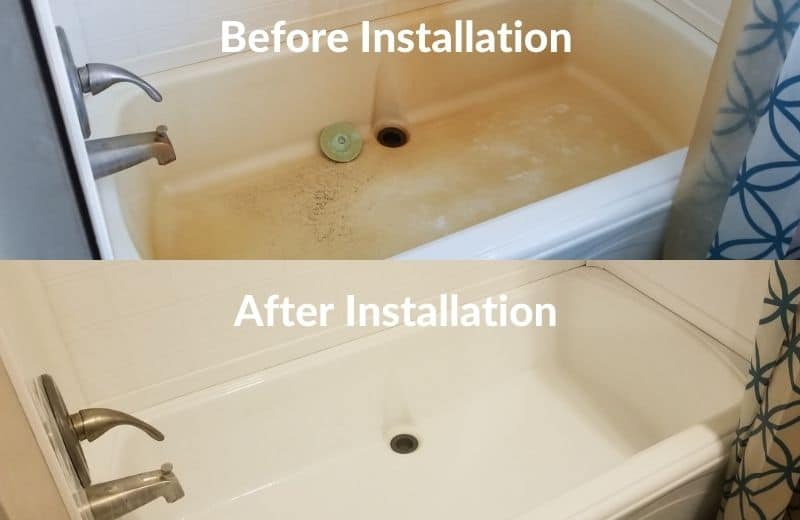
Our readers get 5% off at springwellwater.com 👉 Click here to get your coupon.
Changes to Our Water Flow
We know the importance of flow rate for a point-of-entry water treatment system like the SpringWell WS. If the flow rate is inadequate, it’ll hinder the water pressure throughout your entire home.
We installed the smallest WS1 model, and its 12 GPM flow rate was more than enough for our two-bathroom home.
Most homes have a flow rate of 6-12 GPM, and a minimum flow of 6 GPM is recommended from a well, so the WS1 should be a good fit for most single-family households like ours. Post-install, we didn’t notice a decrease in water flow from our faucets and fixtures, and we were able to use all our appliances as normal.
Performance Efficiency
The SpringWell WS is a backwashing system, which means it periodically sends water through the greensand media to remove the accumulated contaminants, clearing the way for new contaminants.
This feature in itself makes the WS pretty efficient and very cost-effective. By reusing the media again and again, rather than having to regularly replace a filter cartridge, you can save money and materials.
The system’s tank uses vortech technology, which prevents channeling (a process where water flows around rather than through the media) during backwash cycles. According to SpringWell, this improves its efficiency by up to 30%.
On average, the system backwashed every 5 days for us, and the process used less than 70 gallons of water. Based on our research into these systems, the average volume of water used per backwash is 50-200 gallons, putting the SpringWell WS on the more efficient end of the scale. This amount of water isn’t going to overwhelm your septic tank if you have one.
We downloaded the SpringWell app, which we found to be a useful tool for monitoring and programming our system.
On the app, we could remotely schedule backwash cycles, change valve settings, and monitor performance stats, including our water usage data. This helped us to better understand how it was working and make adjustments to improve its efficiency.
Limiting Factors
Finally, we wanted to mention a few limiting factors that related to the SpringWell WS’s performance.
The first is that the system is not designed to treat every well water contaminant you might be dealing with, even if for us, it could remove more contaminants than mentioned on the product page. Contaminants like fluoride and uranium won’t be removed by this system, so you’ll need a separate filtration solution (perhaps a capable countertop water filter system) to remove these.
Second, if you’re dealing with acidic water with a pH lower than 6.5 (a common issue in groundwater wells), you’ll need to install an acid neutralizer upstream of this system to raise the pH. Otherwise, the oxidation treatment won’t work.
Plus, if you’ve had issues with bacteria in your well, the WS might not be the best solution for you at all. Instead, we recommend a chemical oxidation system, which would kill bacteria as well as targeting iron, manganese, sulfur, AND iron/sulfur bacteria.
And finally, if your well water contains more than 7 PPM iron, 8 PPM hydrogen sulfide, and 1 PPM manganese, the WS isn’t going to completely eliminate these minerals, so you’ll want to consider something else.
📑 Filter Testing & Certifications
We tried to find third-party test results online for the SpringWell WS, but there were none on the manufacturer’s website. We think this is the biggest setback of the system, and we have to question why SpringWell hasn’t publicly shared even third-party testing data.
As we mentioned, our own testing showed that the WS could remove contaminants that aren’t even mentioned on the product page. Perhaps the WS is predominantly intended for reducing iron, manganese, and sulfur, but we think it would be beneficial for SpringWell to share test data that proves the system can also remove other heavy metals.
Additionally, we could find no evidence to suggest that this AIO system has any official performance certifications.
While SpringWell is a trusted and reputable manufacturer, we know some folks only feel comfortable investing in a filtration system that has proof of testing or certifications. It’s a shame that SpringWell has nothing to offer in this respect.
We do at least know that the system uses certified components, although we couldn’t find any information about these certifications.
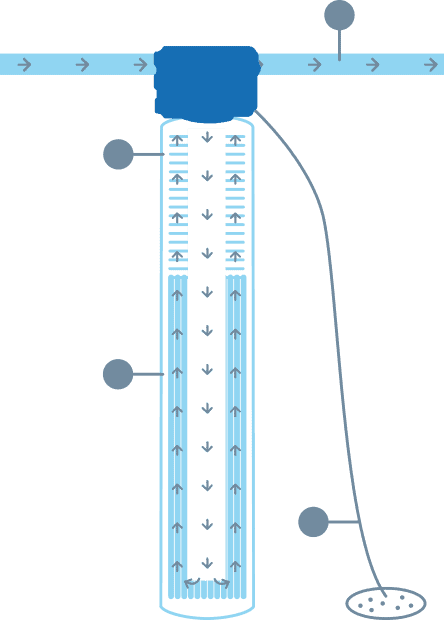
🔧Installation & Maintenance Considerations
The SpringWell WS comes with detailed instructions for installation, and is intended for DIY installation.
That said, if you’re not the DIY type, you may need to call a plumber or a handyman to install the unit for you. We chose to go down this route. Whole-home installations are complex, and we didn’t want to deal with the potential consequences of getting something wrong.
While the installation instructions in the user manual are detailed, we didn’t find them very clear, and the pictures didn’t always give us the insight we needed.
Plus, the filter didn’t come with all the components we required for the install. And the user manual recommends using some plastic components, but our plumber recommended spending more to get more durable, higher quality brass fittings for our installation.
The good news is that, while the install might be challenging, the WS requires virtually no maintenance. The oxidation media has a lifetime warranty and lasts between 18 and 25 years. So yes, the initial investment is high, but the value for money is definitely there.
It’s a “set and forget” system, meaning that once we programmed the settings, we could leave it to do its job. All we had to do was make sure to empty the spin-down sediment filter on occasion.
🤔 Is The SpringWell WS Right for You?
In our opinion, the SpringWell WS is the best well water filtration system for folks who want a reliable, low-maintenance long-term solution for removing iron, manganese, sulfur, and other heavy metals from their well water.
It’s a great choice for folks who want to oxidize and remove these problematic well water contaminants without the use of chemicals, and without having to routinely replace filter cartridges.
If you have the budget for a premium well water filtration system, we don’t think there are many better options out there. The WS is reliable, efficient, and offers the convenience of a lifetime warranty.
However, we don’t recommend the SpringWell WS if your well water has recurring issues with bacteria, or it contains more than 7 PPM iron, 8 PPM hydrogen sulfide, and 1 PPM manganese.
If your budget is small and you just want to protect your drinking water, go for a point-of-use system instead. Just keep in mind that you’ll be missing out on the benefits of protecting your plumbing supply from corrosion and iron stains, which is a key reason why most folks want to remove iron from their water anyway.
Our readers get 5% off at springwellwater.com 👉 Click here to get your coupon.
Continue Reading:
- Our Roundup of SpringWell Water Filter Reviews
- Top Picks of Whole House Well Water Filtration Systems for 2025
Found this review helpful?
Comment below or share this article!

